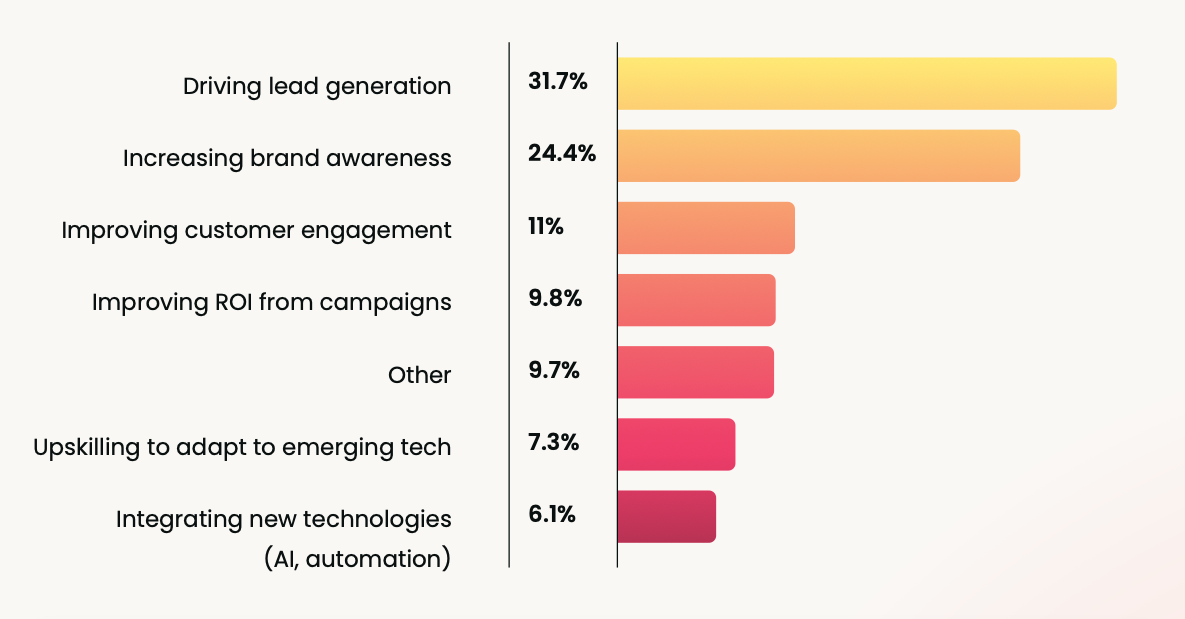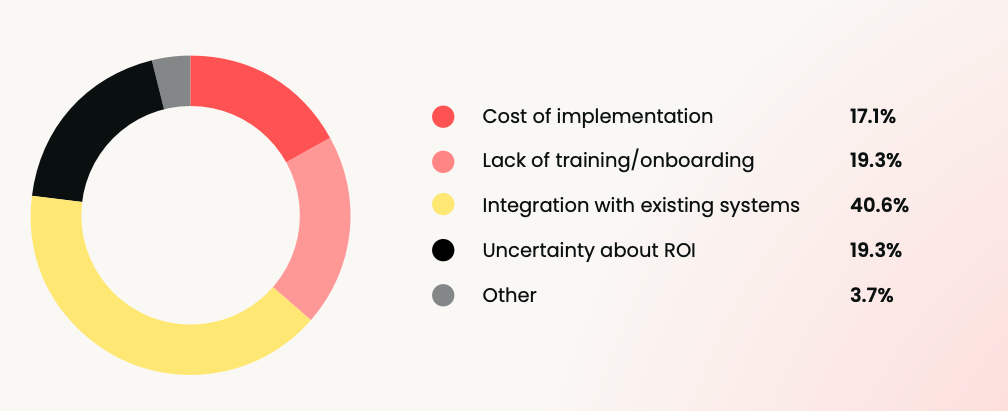Earlier this year, we began working on a report exploring the future of marketing. There's a lot of noise on the topic – much of it conjecture – so we wanted to hear from actual marketers on what they think the profession will look like in 1, 5, 10 years' time.
When setting out to create this report, we knew one topic would likely dominate the discussion: artificial intelligence (particularly the generative variant). Now, almost a year later, we have the data on how marketers are using AI, and more importantly, how they think the technology will transform the marketing profession in the years to come.
All the data is laid out in our Future of Marketing Report (which is available for free right now), but in the meantime, we wanted to highlight a paradox, or tension, in the way AI is being adopted within the marketing space – namely, the curious gap between enthusiastic individual adoption and organizational hesitancy and inertia.
The tension at the heart of AI adoption
Some of the numbers on AI adoption are striking: 89% of marketers are using AI tools "regularly", and of that number, 62% report that the technology has made them "a lot more efficient". Tools like ChatGPT have become as ubiquitous as email clients, with 80% of marketers using OpenAI's chatbot as their go-to AI platform. Content that once took hours to create now takes minutes. Campaign analytics that required dedicated analysts can now be generated instantly.
But that's not the whole story. Beneath this efficiency revolution lies a tension that's keeping marketing leaders awake at night.

When asked about AI's impact on the job market over the next five years, marketers are almost perfectly split: 46% believe AI will create new marketing jobs, while 44% predict it will lead to job losses.
That a split exists over the question of job displacement is hardly surprising. There are still many unknowns. But the reality is likely more nuanced than a binary choice. AI won't simply eliminate roles or spawn new ones wholesale. Instead, it will broadly reshape what marketers do, how teams are structured, and what skills become valuable. The marketers who thrive will be those who understand this shift and position themselves accordingly.
Why most organizations are stuck
If AI is so transformative, why aren't more organizations fully embracing it?
Our data reveals a striking pattern: 3 years after the explosion of generative AI technology, 52% of organizations are still in the "testing and pilot programs" stage of AI adoption. And another 26% are in early exploration. That means over three-quarters of marketing organizations are still experimenting rather than fully integrating AI into their workflows.
Only 18% have achieved full integration into their workflows. This is remarkable when we consider that 9 in 10 marketers are already using AI tools regularly, and the vast majority report significant efficiency gains. There's clearly a gap between individual adoption and organizational transformation.

The barriers are real and tangible. When we asked marketers about their biggest challenges in adopting new technologies, 41% pointed to integration with existing systems as the top hurdle. Many marketing teams are dealing with legacy platforms, siloed data sources, and fragmented tech stacks. Adding AI without disrupting workflows or duplicating effort is genuinely difficult, especially in larger or more mature organizations.
But there's a deeper issue at play, one that reveals a strategic disconnect that could prove costly.
The strategic blind spot: Tomorrow's priority problem
Here's where things get interesting, and frankly, concerning.
When we asked marketers to identify which trend would have the most significant impact on the future of marketing, AI and machine learning dominated with 51% of responses. It wasn't even close: Personalization at scale came in a distant second at 21%.
But when we asked about top priorities for the year ahead, integrating new technologies like AI and automation ranked near the bottom at just 6%. Upskilling to adapt to emerging tech fared only slightly better at 7%.

A bias towards "business as usual" is pervasive.
Marketers overwhelmingly believe AI will reshape their industry, but very few are prioritizing the work needed to prepare for it.
So what's crowding out AI investment? The usual suspects: driving lead generation (32%) and increasing brand awareness (24%) dominate the priority list. These are important, revenue-linked objectives that face immediate pressure and scrutiny. But they represent short-term thinking at the expense of long-term positioning.
As Petr Hloušek, CMO at ALVAO, puts it:
Many companies, not just marketing teams, are still surprisingly hesitant. They talk about data privacy, legal risks, or compliance, but often it’s just fear, lack of time, or underestimating the potential. AI isn’t going away. The real risk isn’t leaking data – it’s leaking relevance. The companies who learn to use it early (and wisely) will win.
This pattern — recognizing AI's importance while failing to prioritize its integration — creates a vulnerability. Organizations are essentially sleepwalking into an AI-powered future they haven't prepared for. And while they're focused on this quarter's lead generation numbers, their more forward-thinking competitors are building the infrastructure and capabilities that will define the next era of marketing.
The question isn't whether to prioritize AI integration. It's whether you can afford not to.
Is data complexity stalling AI adoption within marketing?
When we asked marketers about their biggest obstacles to adopting new technologies, integration with existing systems topped the list at 41%, significantly ahead of cost (17%), lack of training (19%), or uncertainty about ROI (19%).

This isn't just about plugging in a new tool. AI requires something fundamentally different from previous marketing technologies: unified, clean, accessible data flowing across platforms. Many organizations don't have this.
Instead, they have what's often described as "data chaos": customer information scattered across CRM systems, marketing automation platforms, analytics tools, and spreadsheets. Purchase history lives in one system, website behavior in another, email engagement in a third. These systems rarely talk to each other effectively, and when they do, the data is often inconsistent, incomplete, or outdated.
For AI to deliver on its promise — whether that's personalization, predictive analytics, or intelligent campaign optimization — it needs to see the complete picture. Feed it fragmented data, and you get fragmented results. The old technology adage holds true: garbage in, garbage out.
The personalization paradox
The irony is particularly acute when it comes to personalization, one of AI's most compelling use cases. Our research shows that 68% of marketers believe hyper-personalization will become the norm in the near future, and 66% are already leveraging first-party data to make it happen.
But dig deeper and the challenges emerge. When asked about the biggest hurdles to implementing personalization, 72% pointed to data quality and integration, by far the most common response. Privacy and compliance came in second at 49%, followed by measuring ROI at 43%.
In other words, the very thing AI needs to excel at personalization — comprehensive, unified customer data — is precisely what organizations struggle to provide.
This is compounded by the regulatory environment. A striking 73% of marketers say data privacy regulations like GDPR and cookieless advertising have had a significant or very significant impact on their marketing strategy. The third-party cookie, which for years provided a shortcut to understanding customer behavior across the web, is disappearing. Tracking restrictions are tightening. Attribution is becoming more difficult, not easier.
Organizations are being asked to do more with AI using less data, or at least less easily accessible data. It's no wonder that 55% predict a zero- and first-party data "takeover" in future personalization strategies. But building robust first-party data collection and unification systems is exactly the kind of complex, unglamorous infrastructure work that organizations struggle to prioritize and fund.
What this means for AI adoption in marketing
The data challenges are central to AI adoption. While individual marketers can derive value from AI tools working with whatever data they have access to, organizations trying to deploy AI at scale run into these problems immediately:
- Personalization engines can't deliver individualized experiences when customer data is fragmented across systems
- Predictive analytics produce unreliable predictions when trained on incomplete or inconsistent data
- Attribution models can't accurately measure campaign effectiveness when touchpoints aren't connected
- Automated optimization makes suboptimal decisions when it can't see the full customer journey
- AI-powered insights miss critical patterns when data silos prevent comprehensive analysis
This is why 52% of organizations remain in pilot mode. Pilots can work around data limitations. They operate in controlled environments with carefully curated datasets. But when you try to scale AI across the entire marketing operation, you smash directly into these foundational data problems.
The organizations currently stuck aren't necessarily less ambitious or less capable than the 18% who have achieved full AI integration. They may simply have more technical debt, more complex legacy systems, or more regulatory constraints to navigate.
But the clock is ticking. Every quarter spent in pilot mode is a quarter where more nimble competitors are building the data infrastructure and AI capabilities that will define the next era of marketing. The 40% struggling with integration challenges can't afford to treat data infrastructure as something to fix "eventually."
It's not just plumbing. Rather, it's the foundation everything else is built on. And without it, AI adoption at the organizational level will remain perpetually aspirational rather than operational.



 Follow us on LinkedIn
Follow us on LinkedIn


